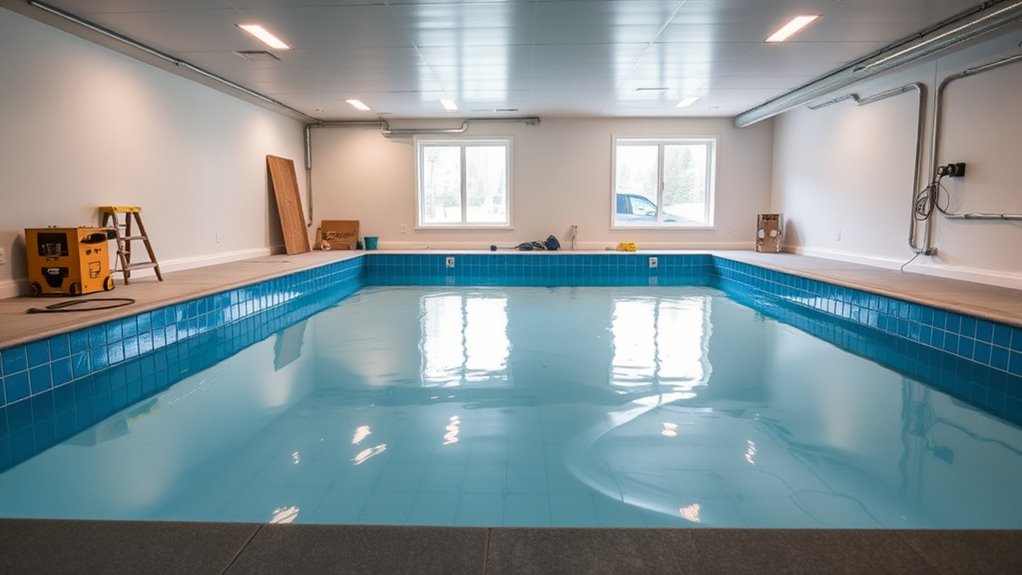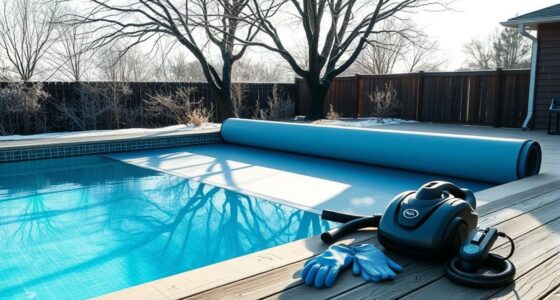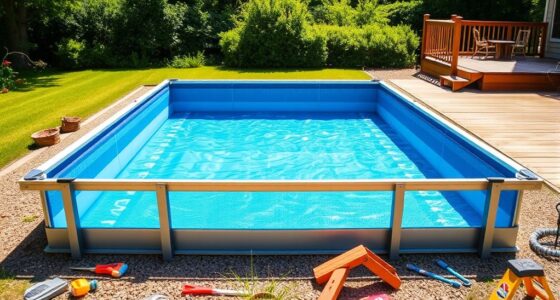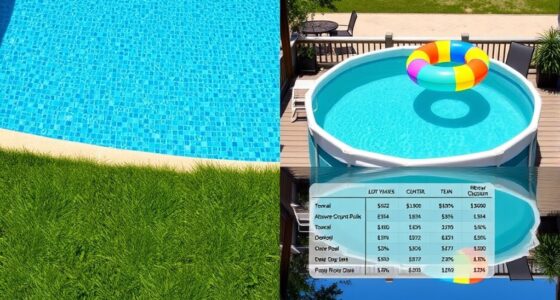Installing a pool in your basement can be a luxurious addition, providing privacy and temperature control year-round. However, it comes with challenges like structural stability, intricate waterproofing, and local code compliance. You’ll need to carefully consider design options and ongoing maintenance requirements, which can be more demanding than outdoor pools. Furthermore, understanding the environmental impact and cost implications is vital. Interested in how to navigate these complexities and guarantee a successful project? There’s more to explore.
Key Takeaways
- Assess the structural integrity of your home with a structural engineer to support the weight of a basement pool.
- Ensure compliance with local building codes and obtain necessary permits for renovation and pool installation.
- Plan for effective waterproofing and drainage to prevent water accumulation and damage to your home.
- Regular maintenance and chemical management are crucial for hygiene and safety in an indoor pool environment.
- Engage professionals, including architects and contractors, to navigate design complexities and regulatory challenges effectively.
Unique Advantages of Basement Pools
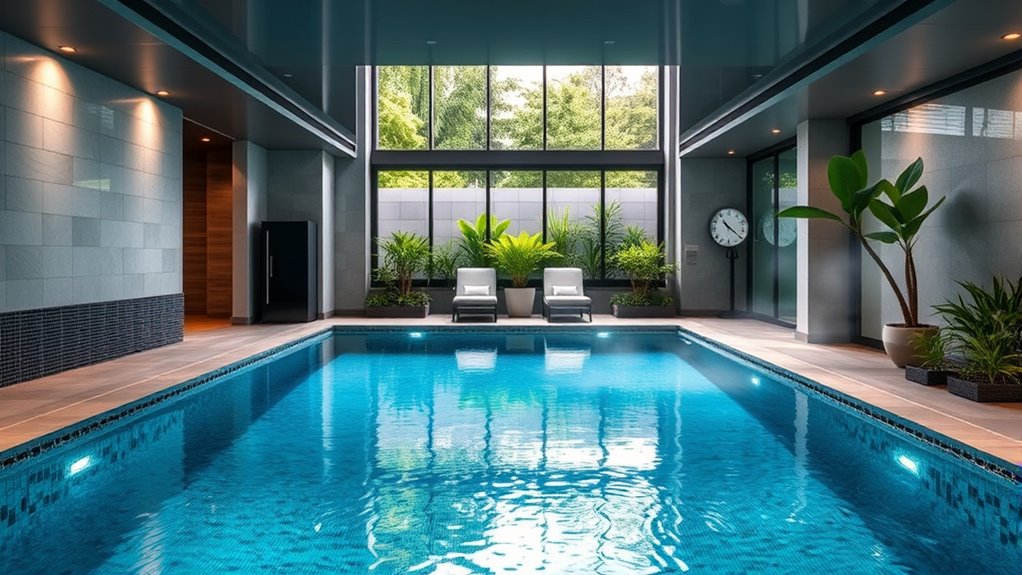
One of the standout benefits of having a basement pool is the exceptional privacy it offers. You can enjoy your swim without worrying about prying eyes from neighbors or passers-by.
Plus, the stable indoor environment of a basement pool means you’ll have a consistent water temperature, allowing for year-round use, no matter the weather outside.
The controlled indoor climate of a basement pool ensures a perfect swimming temperature all year round, regardless of outdoor conditions.
By installing a pool in your basement, you’re transforming an underused space into a luxurious leisure zone for relaxation and exercise.
The unique design options, like glass walls and integrated entertainment spaces, can elevate your home’s aesthetics, adding a modern touch.
Advanced heating and ventilation systems will guarantee peak comfort and air quality, making your indoor swimming experience truly enjoyable.
Key Design Considerations for Indoor Pools
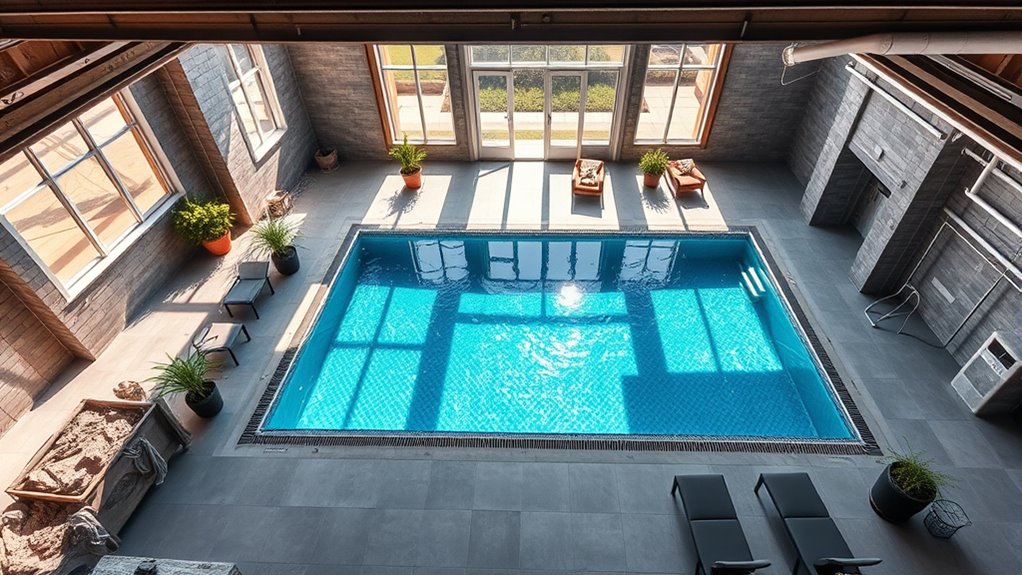
When you’re designing your indoor pool, think about how to best utilize the available space and layout for both functionality and aesthetics.
Effective ventilation and humidity control are key to maintaining a comfortable environment and protecting your home.
Plus, integrating the pool with its surroundings can create a stunning visual appeal that enhances your overall experience. Additionally, consider using natural materials in the surrounding decor to create a cohesive and inviting atmosphere.
Space Utilization and Layout
To create a functional and inviting indoor pool space in your basement, you must carefully assess the available area and design layout. Start by confirming there’s at least 10-15 feet of clearance for construction equipment.
Consider the dimensions of your pool; a common lap pool size of 10 feet wide by 45 feet long can greatly impact your design. Incorporating natural light through windows can enhance comfort and prevent a confined feeling.
Prioritize safety features by allowing ample space around the pool for lounging and maintenance, and guarantee compliance with local regulations.
Finally, choose aesthetic materials like porcelain pavers and natural finishes to create a harmonious integration with your existing basement swimming environment, elevating the overall ambiance.
Ventilation and Humidity Control
While designing your indoor pool, prioritizing effective ventilation and humidity control is vital for maintaining a comfortable and safe environment.
Aim for a relative humidity of 50-60% to prevent mold growth and structural damage. To achieve this, consider advanced mechanical ventilation systems, such as large fans and dehumidifiers, to manage the warm, moist air generated during pool activities.
Natural ventilation can be an option too, using windowless openings, but plan carefully to guarantee sufficient airflow without sacrificing temperature control.
Proper humidity control protects not only the pool structure but also enhances user comfort, as excessive humidity can lead to discomfort.
Regular maintenance and monitoring of humidity levels are fundamental for the longevity of your pool environment and surrounding structures.
Aesthetic Integration With Surroundings
Integrating aesthetics with your indoor pool design not only enhances its beauty but also creates a harmonious environment within your home.
Use glass walls or large windows to connect your indoor pool with the outdoors, inviting natural light and views of the landscape. Incorporate natural materials like sandstone and porcelain for decking to align with your home’s existing aesthetics.
Design adjacent entertainment spaces, such as lounges or wet bars, to flow seamlessly into the pool area, promoting relaxation. Add landscaping elements like indoor plants or water features to soften connections and elevate appeal.
Finally, emphasize minimalist design with clean lines and functional layouts, ensuring your indoor pool remains a stunning focal point without overwhelming the space.
Structural Challenges in Basement Pool Construction
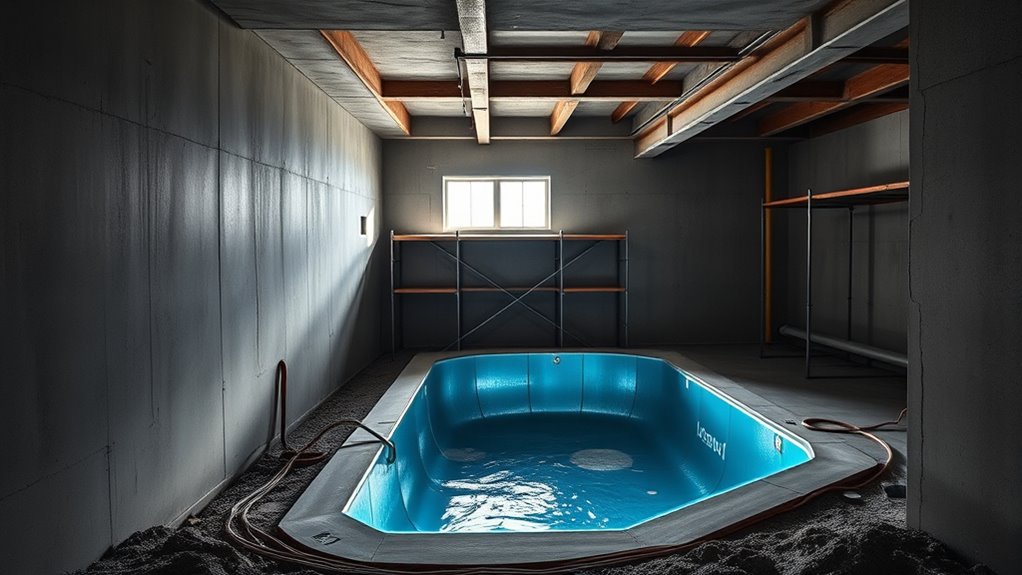
When you’re considering a basement pool, you’ll face some serious structural challenges.
Excavation can affect your home’s stability, so getting a structural engineer on board is essential.
Plus, you’ll need to think about waterproofing and insulation to protect your space from moisture damage.
Excavation and Structural Stability
Excavating for a basement pool demands careful consideration of your home’s structural integrity, as improper planning can lead to significant issues. Here’s what you need to keep in mind:
- Consult a Structural Engineer: Before excavation, get an assessment to guarantee your home can handle the additional weight of the pool and water.
- Evaluate Foundation Strength: Check if your existing foundation needs modifications to support the new load.
- Follow Building Codes: Assure compliance with local regulations to avoid penalties and meet safety standards during excavation.
- Plan for Drainage: Incorporate proper drainage solutions to manage runoff and prevent water accumulation that could damage your home.
Long-term monitoring might also be necessary to address any settling or shifting post-installation.
Waterproofing and Insulation Needs
After ensuring your home’s structural stability through careful excavation, the next step involves addressing waterproofing and insulation needs.
Effective waterproofing is essential to prevent leaks that could compromise your home’s integrity and lead to costly repairs. Install a high-quality waterproofing membrane on the pool walls and surrounding area for a watertight seal against moisture intrusion.
Insulation is also important for maintaining the pool’s temperature and enhancing energy efficiency. Consider using rigid foam boards or spray foam insulation.
Additionally, integrate proper drainage solutions to manage water runoff and prevent accumulation around the pool, which can cause structural damage.
Finally, utilize specialized materials, like moisture-resistant drywall and vapor barriers, to combat humidity and maintain a safe indoor environment.
Navigating Local Building Codes and Regulations
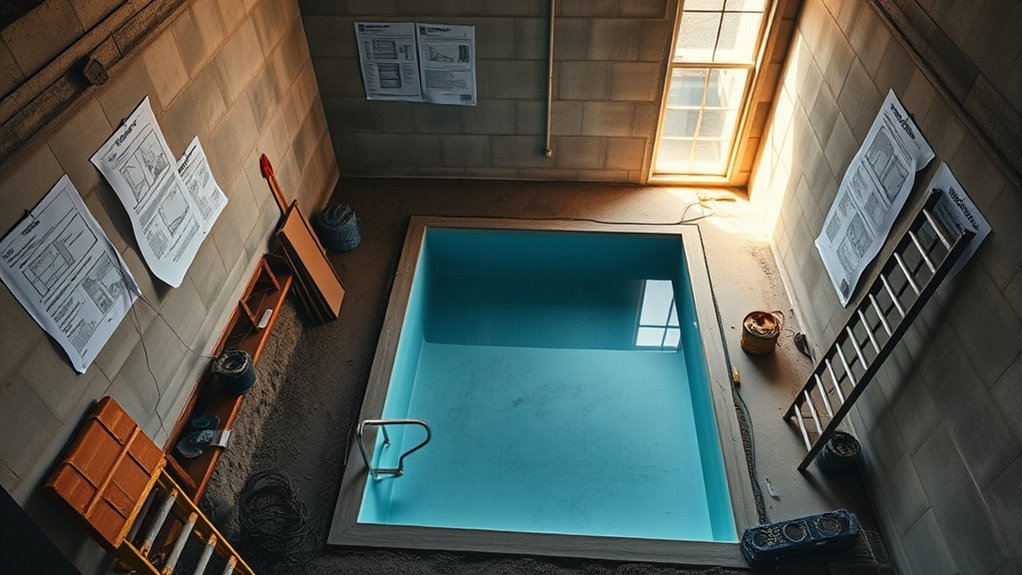
Before you plunge into installing a pool in your basement, it’s essential to navigate the local building codes and regulations that govern such projects. Here are key points to contemplate:
- Structural Requirements: Check for guidelines on waterproofing and ventilation.
- Permits: Most municipalities require specific permits for basement renovations, including swimming pools. These may involve inspections.
- Zoning Regulations: Verify setback requirements and limitations on impervious surfaces that could impact your project.
- Safety Criteria: Adhere to local ordinances regarding pool enclosures, which mandate proper fencing or barriers for child and pet safety.
Engaging with local building authorities early in the planning process can clarify regulations and help you avoid potential legal issues or construction delays.
Maintenance Requirements for Indoor Swimming Pools

Maintaining an indoor swimming pool can be more demanding than you might expect, especially due to its enclosed environment.
You’ll need advanced ventilation systems to control humidity and prevent mold growth. High-quality filtration and cleaning systems are essential for water clarity and safety, requiring regular checks to maintain ideal chemical balance.
Routine tasks include monitoring water temperature, testing pH levels, and cleaning pool surfaces and filters to guarantee hygienic conditions.
Regularly checking water temperature, pH levels, and cleaning surfaces ensures your indoor pool remains safe and hygienic.
Additionally, you’ll need to manage heating systems to sustain comfortable water temperatures year-round, which can increase energy costs.
Specialized equipment may also be necessary, leading to higher overall maintenance requirements for indoor swimming pools compared to traditional outdoor pools.
Being proactive will help you enjoy your pool without significant headaches.
Environmental Impact and Water Table Considerations

When considering the installation of a pool in your basement, it’s essential to understand its potential impact on the local water table and environment. Here are some key factors to keep in mind:
- Water Table Levels: A basement pool can raise water levels in nearby areas due to increased saturation from operation and drainage.
- Water Management: Proper management of water use and chemicals is critical to prevent groundwater contamination.
- Regulatory Compliance: Environmental regulations may limit water discharge, requiring a plan for overflow and drainage.
- Soil Assessment: Evaluate your soil’s composition and drainage capabilities to avoid foundation damage and mold growth.
Long-term monitoring of the water table is essential to protect the surrounding ecosystem and prevent flooding issues.
Cost Implications of Basement Pool Installation

Installing a pool in your basement can greatly impact your finances, both upfront and in the long run. The cost of construction for an inground pool can easily reach six figures, factoring in excavation and complex installation. Ongoing expenses, such as chemicals for water treatment and electricity for the pump, add to the total costs. Regular maintenance, including cleaning services, will also require budgeting. Additionally, don’t overlook potential unexpected expenses related to structural modifications or waterproofing measures. Finally, consider the long-term implications, like increased property taxes and impacts on your property value.
| Cost Factors | Estimated Cost | Notes |
|---|---|---|
| Initial Construction | $100,000+ | Complexity of basement work |
| Ongoing Maintenance | $200/month | Cleaning and chemicals |
| Utilities (Electricity) | $50/month | Pump and filter operation |
| Unexpected Expenses | Variable | Waterproofing, modifications |
| Property Value Impact | Variable | Potential increase |
Engaging Professionals for Successful Project Execution
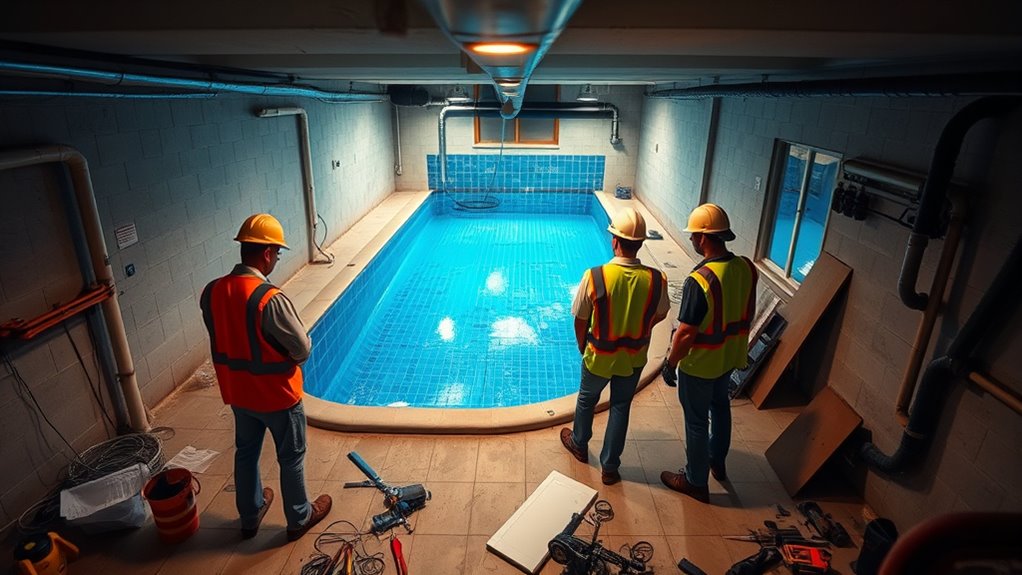
Engaging professionals is essential for the successful execution of your basement pool project, as their expertise can help you navigate complex design and regulatory challenges.
Engaging the right professionals is crucial for navigating the complexities of your basement pool project successfully.
To guarantee a seamless process, make sure to:
- Hire an architect for smart design, considering structural and aesthetic aspects of your pool in the basement.
- Engage a contractor experienced in indoor pools to manage compliance with local building codes effectively.
- Consult a septic specialist to evaluate the impact on your existing system and address any relocation needs.
- Involve mechanical engineers for proper ventilation to control humidity levels around the pool.
Frequently Asked Questions
Can I Build a Pool in My Basement?
You can build a pool in your basement, but it’s not a simple task.
You’ll need to check local building codes and guarantee your basement can handle the structural demands.
Don’t forget about waterproofing and drainage solutions to prevent moisture problems.
Consulting with professionals like architects and contractors is essential for planning and cost estimates.
Make certain to assess any nearby septic systems, as they may need adjustments or relocation.
How Much Does It Cost to Put a Pool in Your Basement?
Putting a pool in your basement can cost you six figures, considering construction, waterproofing, and heating systems.
You’ll also need to factor in ongoing expenses like chemicals, electricity, and maintenance. Excavation complexities can drive up costs, so be prepared for potential overruns.
It’s wise to set aside a contingency budget.
Don’t forget to think about the long-term financial implications, like property taxes and maintenance costs, when planning your project.
Does Installing a Pool Increase Homeowners Insurance?
Yes, installing a pool can increase your homeowners insurance.
You’ll likely face higher premiums due to the added risks of water damage and liability issues. Insurers may require you to raise your coverage limits to protect against potential damages linked to the pool.
It’s essential to inform your insurance provider before installation to avoid coverage problems later.
To gauge the financial impact, compare quotes from multiple insurance companies.
Can a Pool Cause Foundation Problems?
Yes, a pool can cause foundation problems. The added weight and hydrostatic pressure from the water may lead to cracking or shifting in your foundation.
If you’re planning to install a pool, it’s vital to evaluate the stability of the soil and the foundation. You’ll also need to take into account waterproofing measures to prevent water intrusion and guarantee proper drainage to avoid further complications.
Regular monitoring after installation is essential to catch any issues early.
Conclusion
Installing a pool in your basement might seem intimidating, but imagine the joy of diving into a warm, tranquil oasis right at home, regardless of the weather outside. While concerns about moisture and structural integrity are valid, with the right planning and professional help, you can create a stunning retreat that enhances your lifestyle. So, don’t let fears hold you back; picture those sunlit summer days spent swimming in your own private paradise, just a few steps away.
